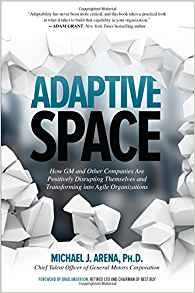Adaptive Space
How GM and Other Companies Are Positively Disrupting Themselves and Transforming into Agile Organizations


Michael J. Arena has been Chief Talent Officer at General Motors since 2012. He has a PhD in Organizational Dynamics and has been involved with a major practitioner-academic research project led by Prof Mary Uhl-Bien at Texas Christian University that has culminated in the Adaptive Space model.
Reed Hastings, the much admired founder of Netflix, noted that “companies rarely die from moving too fast; and they frequently die from moving too slowly”, to which Arena adds, ‘in today’s rapidly changing environments, lack of agility is the kiss of death’. We see this in all sectors: fixed telecoms being challenged by free calling apps; fintech challenging the banking behemoths; auto-giants being threatened by Uber, Tesla and even Dyson; retail veterans succumbing to Amazon, the list goes on and on. Arena asserts that ‘in today’s dynamic environment, organizations need to be more liquid than static, yet many stubbornly cling to outdated control models….they have perfected operations at the expense of agility’.
The original research question they set out to answer was “what is the process by which ideas emerge and flow n the organization?”. The spark for the image of the answer, as Arena notes, that in 1989 sociologist Ray Oldenburg ‘pioneered the concept of a ‘third place’’, a ‘free trade zone’ that provides a sense of connectivity that facilitates and fosters more creative interactions. This is the basis of ‘adaptive space’, which enables three key key activities: opening connections for people, ideas and information; fostering environments where organizations can be positively disruptive before others; and creating bridges between fragmented pockets of entrepreneurialism dotted throughout organization and connecting them to the more formal operational system.
But creating Adaptive Space is not easy. Organizations dislike ambiguity and are more likely to shut such space down than nurture it. Arena’s company, GM, has made some significant strategic bets to streamline itself, closing operations in Russia, India and S Africa and selling its European Opel/Vauxhall brand to Peugeot Citroen. This increases its agility, but does not create Adaptive Space, that is done by focusing on the social, rather than human,capital around its various ‘mobility’ bets, into Lyft, Cruise Automation and the Chevy Bolt.
The model relies on 4Ds of Connection:
• Discovery Connections: encouraging exploration and curiosity to find like minded subgroups in your organization. ‘Brokerage’, the active promotion of your thinking to attract others, is key.
• Development Connections: ‘Ideas alone are cheap – they need to be socialised, developed and applied’. This is where Connectors and local groups earn their value, being cohesive and already well-connected.
• Diffusion Connections: Adaptive Space engages network energy to enable bold change to occur. ‘Energizers’ in organizational networks are vital to promote and drive new behaviours forward.
• Disruption Connections: ‘formalisation is the final step in agility’ endorsing the new solution into the formal operational structure. Leaders, by definition, are decision-makers, and need to be able to say ‘no’ more often than they say ‘yes’ to the flow of options and alternatives they are presented with. This makes getting formal approval the hardest step in the Adaptive Space process. ‘Challengers’ are required who are comfortable disrupting existing structures and embracing new ones. Social momentum for an idea is a powerful catalyst for getting approval, ‘gossip, social ownership and network closure allows ideas to amplify and spread, ultimately causing network buzz that can positively influence an operational leader’.
This book explores and broadens an increasingly important concept on improving organizational performance in the twenty-first century, the power of social networks, and the realisation that while organizations increased their performance by transactional efficiency gains in the last century, they will have to look to relational processes, again (humans, after all, have been doing this for all our existence) as part of the solution going forward. Profitable business requires efficient transactions, but a relational, social network, focus is the necessary oil to lubricate those wheels.
Title: Adaptive Space: How GM and Other Companies Are Positively Disrupting Themselves and Transforming into Agile Organizations
Author/s Name/s: Michael J Arena
Publisher: McGraw Hill Education
ISBN: 978-1-260-118-025
Publishing Date: June, 2018
Number of Pages: 244
Author Knowledge Rating: 1-5 (based on their years of experience, academic expertise in subject areas, and exposure to cross-functional thinking in the area)









































































Readability: 1-5 score(1=dense and v academic; 5=frantic; page turner)












































































Appropriate Length: (1=could have been written in 25% of the length;5=could have been longer)












































































Core Idea Value: (1=nonsense (or entirely esoteric); 5=game-changer)











































































